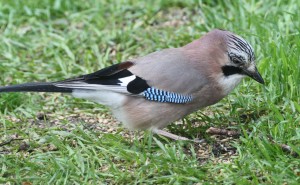 There are seven members of the “crow” family in the Highlands and they vary considerably in their numbers. The four commonest are the carrion crow, the hooded crow, the rook and the jackdaw. Much rarer is the raven which, with the golden eagle, is one of the very few birds that spend the winter in the open landscape of the hills, moorlands, glens and straths. Ravens are one of the earliest birds, if not the earliest, to start breeding and in February they may well have the first eggs in the nest. The nests are on high, very steep, cliff ledges. There is the suggestion that the numbers of breeding ravens are increasing which is, perhaps, a sign of the decrease in persecution.
There are seven members of the “crow” family in the Highlands and they vary considerably in their numbers. The four commonest are the carrion crow, the hooded crow, the rook and the jackdaw. Much rarer is the raven which, with the golden eagle, is one of the very few birds that spend the winter in the open landscape of the hills, moorlands, glens and straths. Ravens are one of the earliest birds, if not the earliest, to start breeding and in February they may well have the first eggs in the nest. The nests are on high, very steep, cliff ledges. There is the suggestion that the numbers of breeding ravens are increasing which is, perhaps, a sign of the decrease in persecution.
One bird of the crow family that in no way resembles the rest of the crows as such is the jay with its almost gaudy colours. The photograph shows the remarkable colours of a mainly pinkish- fawn body, the black and white tail and rump and the almost startling blue of the small patch of feathers on the wing. These small blue feathers are much prized by anglers to make flies for fishing. Records suggest that jays are increasing in the numbers of breeding pairs as the birds are moving northwards through the huge and continuous woodland areas of the Great Glen running from Inverness down south west to Fort Augustus. This trend, much like the raven, could be because the endless persecution, because of the jay’s reputation of taking eggs and nestlings, has eased.
The other member of the crow family is large with a conspicuous black and white plumage but, despite this, the bird can still be very elusive and secretive, the magpie. It is the rarest of the crow family in the Highlands and there is evidence that it is declining. Some of the more traditional sites where the magpies bred every year have gone. The nest, compared with other crows, is very unusual in that it is large and domed and it may be started in the winter as it is such a complicated affair. The dome is a masterpiece of construction and is made up of carefully interwoven twigs of varying size. It is very dense and often defies a predator, such as another bird, access. There is one small hole at side just big enough for the adult magpie to slip through.
Magpies are normally only seen in pairs, often only a single bird, but there are exceptions and such was the case last weekend when I went along the coast east of Inverness. In the village of Kinloss was an open field with a scattering of oystercatchers feeding. I stopped to look through the binoculars when I saw the first magpie. I rarely ever see a magpie and the last one was over a year ago and so when I saw there were two in the field it was an even greater surprise. Then suddenly there were three and I was already mentally ticking off the traditional nursery rhyme about magpies that goes “One for sorrow, two for joy, three for a girl”. Then there were four magpies so the next line I recalled as “Four for a boy”. Then, to my amazement, there was a fifth and I could not recall the rhyme that far. In the end there were seven magpies and books later told me “Seven for a secret, not to be told”. Just amazing!
Tags: highland wildlife
